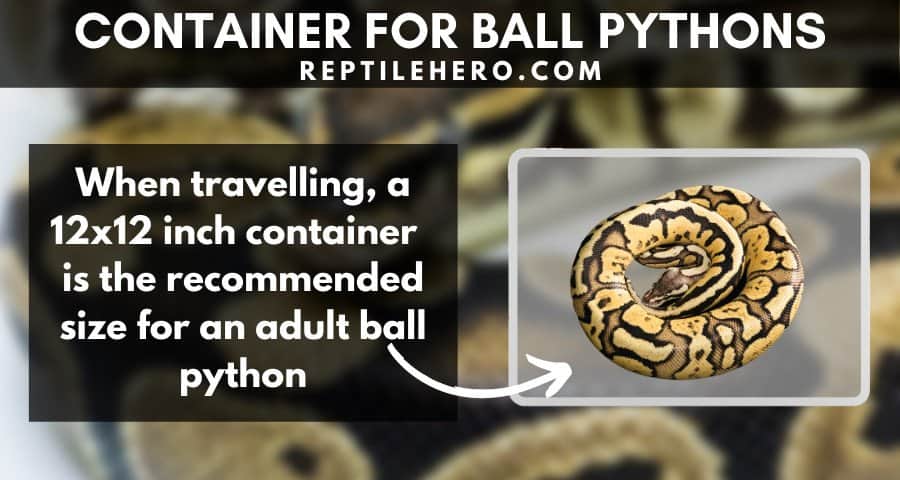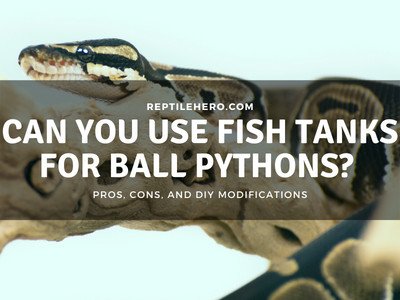How to Travel With Ball Pythons by Car (4 Things to Do!)
Do you need to go somewhere with your ball python? Perhaps, the vet clinic? First, ask yourself, are they safe to travel in cars? When traveling with a ball python, its safety should not be overlooked as it can lead to stress or even injuries.
Car travel is safe for ball pythons as long as 1) the temperature is warm, 2) the container is secure, 3) the trip is short, and 4) the environment is quiet. Ball pythons, in general, are hardy pets and can tolerate travel without food and water, unlike other common pets such as cats and dogs.
Ball pythons are one of the most shipped reptiles in the world. But what should you do when traveling with them in cars? How about after the ride? Learn all of these and more as you read until the end!
1. Warm Temperatures
In car travels, the best temperature for ball pythons is 87–89°F (30–31°C). They should not be exposed to temperatures below 70°F (21°C) and above 95°F (35°C) which can be affected by car heaters, air conditioning, and the weather outside.
So if you are traveling with your ball python, make sure that no airconditioning or heater vents are directed towards the snake.
Keep in mind that manageable temperatures for most of us like 70°F or 95°F will be uncomfortable for a ball python and can cause stress and overheating.
To manage the temperature for your trip, you can use a hot or cold pack that will last around 40–72 hours. This pack should be placed on one side of the container to provide the python with a temperature gradient to choose from.
To be safe you can bring a battery-powered thermometer with a wired probe to be placed inside the ball python’s travel container.
For a portable temperature probe, I recommend this one from Amazon. It is cheap, battery-powered, and can get the job done on trips with your ball python!
>>Are you planning to travel with a leopard gecko? Check out our article about geckos in car transport
2. Secure Containers
Ball python plastic travel containers should be transparent and spacious but neither too big nor too suffocating. Glass enclosures are discouraged to avoid breakage that can cause injuries to the snake and keeper.
For the container’s size, I recommend width to be around the size of a coiled ball python. The height should also be around 4-6 inches so the snake won’t be thrashed up and down during bumps.
Providing an opaque plastic container will lessen stress for a ball python. You can also provide an additional dark, breathable bag for extra security, insulation, and cushion inside.
Ventilation is also important not only for the python’s breathing but also for temperature regulation, especially during hot weather. I recommend placing at least 4 holes on the sides and top of the container.

A keeper honestly shared his mistake when he placed his ball python directly inside a transparent container during car travel. He observed it pacing erratically and fast as the trip went on.
Luckily nothing went wrong when they got home but the poor snake might’ve experienced extreme stress all throughout the trip.
3. Short Trips
Short trips with a ball python are recommended to lessen stress and minimize possible risks like extreme temperatures and motion sickness. When transporting a ball python through a car, the sooner it gets home, the better.
It is recommended that the car travel time of a ball python should be less than 12 hours. Although I prefer it to be around 3–4 hours on average to ensure the ball python’s safety and stress levels are in check.
Especially on overnight trips, your ball python will experience more stress even if you take it inside the place you are staying.
Because not only did he experience a stressful trip in a temporary container, but he will then be exposed to a new environment and this cycle will repeat again the next day.
If you are planning on car travel with your ball python, I suggest that you plan it so that the snake gets home as soon as possible.
In my experience, I picked up my ball python Choco from the breeder in the last part of my trip. So after I got him I immediately went home cutting his total car travel to only 30 minutes!
4. Quiet Environment
When traveling in a car with a ball python, it is recommended to have a quiet environment to lessen stress on the snake. Car speakers, in general, produce more bass and vibrations which will disrupt the python.
Even if they don’t have an exterior ear, ball pythons can sense the vibrations produced by sounds [1]. In addition to its motion, a car’s loud surround speaker will prove to add more stress to the python.
So for the sake of your beloved pet, I suggest that you refrain from listening to music from your car’s speaker.
You can, however, listen to the speaker of your phone which produces less bass and vibration. Just make sure that it is at a low volume and the speaker is not directed to your ball python’s container.
2 Things You Shouldn’t Do During Car Travel With Ball Pythons
During car travel, letting a ball python free roam inside the vehicle is highly discouraged. In addition, leaving the animal inside a parked car for more than 10 minutes is also discouraged.
Even if your ball python seems to be a “chill” snake, if it doesn’t have experience in a moving vehicle, it can change its behavior due to stress.
So imagine that you have your ball python around your neck while driving. A sudden road bump or loud car horn might startle it and cause it to get away from you and go somewhere in the car.
This might even distract you and cause a car accident!
Ball pythons can also fit in tight places so a car’s dashboard can become their hiding place if you choose to let it free roam inside.
In addition to this, I also discourage leaving your python inside a parked car for more than 10 minutes especially if the weather is very hot or cold outside.
Should You Feed Ball Pythons Before or After Car Travel?
Feeding a ball python on or immediately before it travels inside a car can cause stress that leads to regurgitation. Regurgitation is a sign of extreme stress that damages the python’s throat and can even be fatal.
You probably have experience traveling with your dogs and knew that they need water and food along the trip. However, this is not the case for ball pythons.
Feeding a ball python a few hours before transporting them in a car is highly discouraged because they are vulnerable after feeding.
If you want to feed them before car travel, I suggest doing so 3–7 days before the trip. Because a ball python will digest a meal for 2–7 days at a time depending on the size of the prey [2].
For hydration, a ball python will do well without drinking water on the day of travel because they are known to survive without food or water for months at a time!
>>Learn more about the cause of regurgitation in our article overfeeding ball pythons
You also do not need to bring a water bowl inside the python’s container because it will just be a hazard in the moving vehicle which might hit the snake.
2 Tips for When You’re Traveling With Ball Pythons by Car
For safe car travel with a ball python, it is recommended to 1) have another person with you and to 2) familiarize the snake with its container before the trip.
When you have another person accompanying you, they can handle the ball python’s container in their lap which will make it more secure in place.
So during a bumpy ride, you won’t worry about your scaly friend’s safety in regards to being thrown all over the place when another person securely handles the container.
A person can also radiate body heat which is considered minimal but can still serve as an additional heat source!
Other than that, you can start to associate the ball python a week or two before you plan to travel. At first, you can simply place it inside the temporary container for 5 minutes and return it to its enclosure.
Then, you can start to gradually increase this duration to 10 minutes. On the 4th day, you can introduce a bit of motion like carrying the container, with the snake inside, across the room.
Overall, this process can help reduce the stress of the ball python due thanks to the association.
In other words, after a bit of “training” it will be imprinted on the python that after he is placed in the temporary container, he will eventually get back to his original enclosure.
What Should You Do After a Car Ride With Your Ball Python?
After traveling by car, a ball python should be placed either in a designated or quarantine enclosure. It should then be mostly left alone and only fed after 7 days.
I don’t recommend handling your ball python immediately after it came from car travel. Your priority should be to allow it to rest in its hide and be able to rehydrate itself with clean water.
After it ate, I recommend waiting at least 48 hours before attempting to handle your ball python.
When to Quarantine a Ball Python After Car Travel?
Newly acquired ball pythons, from breeders or other keepers, must be quarantined right after the car ride home—especially when there are other reptiles in the house.
Even if the seller stated that it is clean or healthy, it is better to be safe and prevent possible infection of your other reptiles.
For quarantine, the ball python should be kept in another room with a temporary enclosure for at least 60 days.
This enclosure should contain 2 hides and a water bowl. You can also use a paper towel for the temporary substrate which should be cleaned every 2–3 days.
You should also wash your hands thoroughly before handling any of your reptiles to prevent the spread of illnesses from carriers like mites and feces.
Experiences of Keepers Travelling with Ball Pythons
Ball python keepers who have traveled with their pythons by car experienced little to no problems. However, there are a few cases that have encountered an issue.
In my experience and many other keepers, traveling by car with a ball python is not an issue at all. Provided that the snake has a proper container, is kept warm and the travel time does not exceed 12 hours in total.
But one keeper shared that her ball python got out of its container during car travel. She said that the container only has a “press-down” lid which an adult ball python can escape from.
Thankfully, she found somewhere safe to pull over and placed her python back into the container. After that, she temporarily secured it with a straw rope.
Another keeper shared his experience that his ball python became weaker when he brought it home after traveling for 2 days with an overnight stopover.
Even though he brought the snake inside, he concluded that the constant change of environment and motion resulted in great stress for the python. Thankfully it recovered and ate after resting for a week.
Further Questions
Can ball pythons become car sick?
Ball pythons can get motion sickness, due to not only the car’s movement, but also other factors like temperature, light, and sound. This can cause weakness and great stress to a ball python, with some individuals regurgitating recently consumed meals.
Can ball pythons survive being shipped?
Ball pythons can survive being shipped as long as there is a proper heat or cold pack, container, insulation, and cushion. Pythons shipped from one state to another can typically survive 1–3 days in such a secure package.
Can you take your ball python outdoors?
Ball pythons can be taken outdoors as long as there are no predators, they can handle the climate, and are strictly monitored. Taking a ball python outside can provide them with enrichment, sunlight, and ventilation. This is best done within a secure private property and not in a public space.
Summary of Traveling With a Ball Python in a Car
Ball pythons can be transported in cars as long as they have the right temperature, proper container, short travel time, and quiet environment. A ball python should also not be allowed to free roam and be left alone in a parked car.
To make traveling with a ball python easier, having another person monitor and handle the python’s container is better. Keepers are also recommended to familiarize their ball pythons with the temporary container to lessen the stress of traveling.
When the ball python reached its final destination, it is recommended to either place it in its designated or quarantine enclosure. Then it should be left alone to rest for about 7 days and offered food right after.







